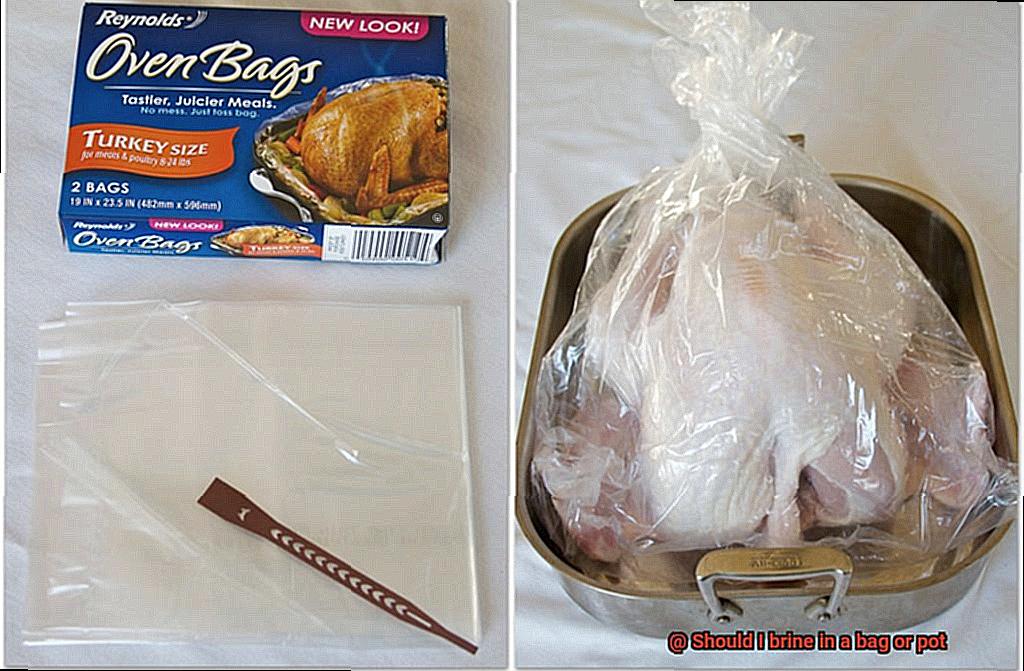Are you a meat lover who craves juicy, tender, and flavorful dishes? If so, brining is the perfect solution. This technique involves soaking your meat in a saltwater solution to enhance its taste and texture. But the question remains: should you use a bag or pot for brining?
The debate on this topic has been ongoing for ages, with some cooks swearing by using a large pot and others opting for a plastic bag. So which one is better? In this blog post, we’ll explore the pros and cons of each method to help you make an informed decision.
We’ll delve into how the container impacts the effectiveness of the brine and how it affects the meat’s flavor and texture. Whether you’re a seasoned pro or just starting out in the kitchen, mastering the art of brining is essential to creating mouth-watering dishes.
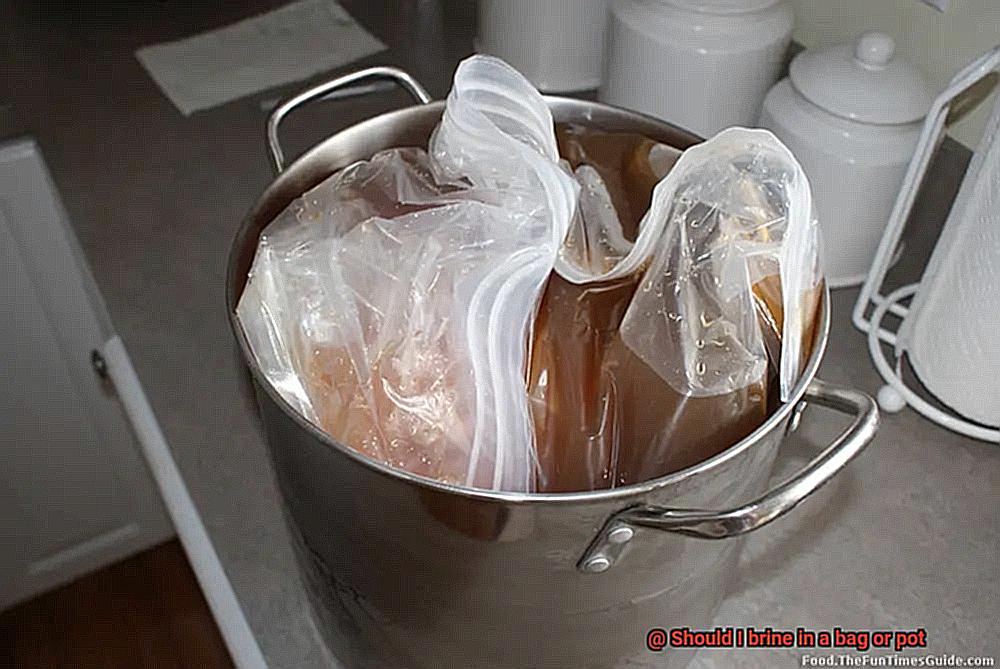
So let’s dive into this delicious world of brining together and discover whether a bag or pot is best suited for your cooking needs. Get ready to elevate your meat game like never before.
Contents
What is Brining?
Brining is more than just a cooking technique, it’s a game-changing process that can take your meat and poultry dishes to the next level. At its core, brining involves soaking the meat in a solution of salt, sugar, and water before cooking. But why should you bother with this extra step? Well, the benefits are numerous.
Firstly, brining adds moisture to the meat while also tenderizing it. The salt in the brine helps break down the muscle fibers, allowing water to be absorbed into the meat. This results in a juicy and succulent end product that is bursting with flavor. Additionally, sugar is often added to the brine to balance out the saltiness and add a subtle sweetness to the meat.
But brining isn’t just about salt and sugar – it’s also an opportunity to get creative with various herbs, spices, and other flavorings. Some popular additions include thyme, rosemary, black pepper, cumin, vinegar, or citrus juice. The possibilities are endless, so don’t be afraid to experiment until you find a recipe that suits your palate.
When it comes to brining vessels, there are two main options: bags and pots. Brining bags are ideal for smaller cuts of meat as they allow for easy submersion and take up less space in the refrigerator. On the other hand, pots are better suited for larger cuts of meat or those who prefer a more traditional method of brining. Ultimately, the choice of vessel comes down to personal preference and the size of the meat being brined.
Regardless of which vessel you choose, it’s crucial to give yourself enough time for the brining process to work its magic. Depending on the size and type of meat you’re using, you’ll want to let it soak in the brine for anywhere from 30 minutes to 24 hours. After brining, rinse off the meat and pat it dry before cooking to ensure optimal flavor and texture.
Advantages of Brining in a Bag
This method has gained immense popularity in recent years, and for good reason. Not only is it hassle-free and mess-free, but it can also result in some seriously succulent and flavorful meat.
Let’s start with the convenience factor. When you brine in a bag, you don’t need a large container to hold your meat and brine solution. Instead, you can easily seal everything together in a bag and store it in the fridge. This not only saves space but also makes it easier to move around and manipulate the meat as needed. Plus, when you’re done brining, you can simply toss the bag away.
Another significant advantage of brining in a bag is the reduced mess factor. With a pot, there’s always a risk of spills and splashes, which can be a pain to clean up. The bag eliminates this issue entirely since everything is contained within its own little ecosystem. You can say goodbye to cross-contamination fears and accidental spills.
But what about the potential results from brining in a bag? The fact that the meat is fully submerged in the brine solution with no air exposure means that flavors and moisture penetrate more deeply into the meat. This results in tender, juicy, and flavorful meat when cooked. Additionally, since the bag conforms to the shape of the meat, you’ll get even coverage and consistent results every time.
Advantages of Brining in a Pot
If you’re looking to elevate the flavor and texture of your meat, brining is an age-old culinary technique that’s worth exploring. While there are different methods for brining meat, using a pot is one of the most efficient and effective ways to do it. Here’s why:
Firstly, using a pot gives you superior control over the brine solution. Since pots are generally larger than bags, they can hold more liquid, which means that you can adjust the concentration of salt and other flavors more precisely. Furthermore, pots are easier to stir and mix, ensuring that the brine solution is evenly distributed throughout the meat. This even distribution results in a more consistent, flavorful end product.
Secondly, using a pot enables optimal temperature control. Brining in a bag can be challenging because it’s difficult to maintain a consistent temperature. Bags tend to float or shift around in the liquid, making it harder to regulate the temperature. In contrast, a pot is more stable and can be placed on a stove or in a refrigerator to keep the temperature consistent.
Thirdly, using a pot is environmentally friendly. Bags are often single-use and can contribute to plastic waste. Pots, on the other hand, can be reused multiple times and are less likely to end up in landfills. So not only are you creating delicious food, but you’re also making an eco-friendly choice.
Finally, using a pot makes clean up a breeze. Bags can be messy and difficult to dispose of properly, whereas pots can simply be washed and reused or stored away. This makes the whole process of brining much less cumbersome.
Factors to Consider When Choosing Between Brining in a Bag or Pot
Brining is a fantastic way to elevate the flavor and texture of your meat, but choosing between a bag or pot can be a tricky decision. As an expert in this field, I’m here to guide you through the factors to consider when making this choice.
Firstly, size matters. If you’re working with smaller cuts of meat like chicken breasts or pork chops, a bag may be the most practical option. Bags are flexible and can easily fit into your fridge without taking up too much space. However, for larger cuts like turkey or brisket, a pot is the better choice as it allows for full submersion of the meat and even brining.
Secondly, convenience is key. Using a bag can be less messy and more straightforward than using a pot. All you need to do is add your brine ingredients and meat to the bag, seal it up, and pop it in the fridge. Clean-up is also a breeze since you can simply dispose of the bag afterwards. However, using a pot requires more effort and cleaning up afterward as you need to find a large enough pot for your meat and brine solution.
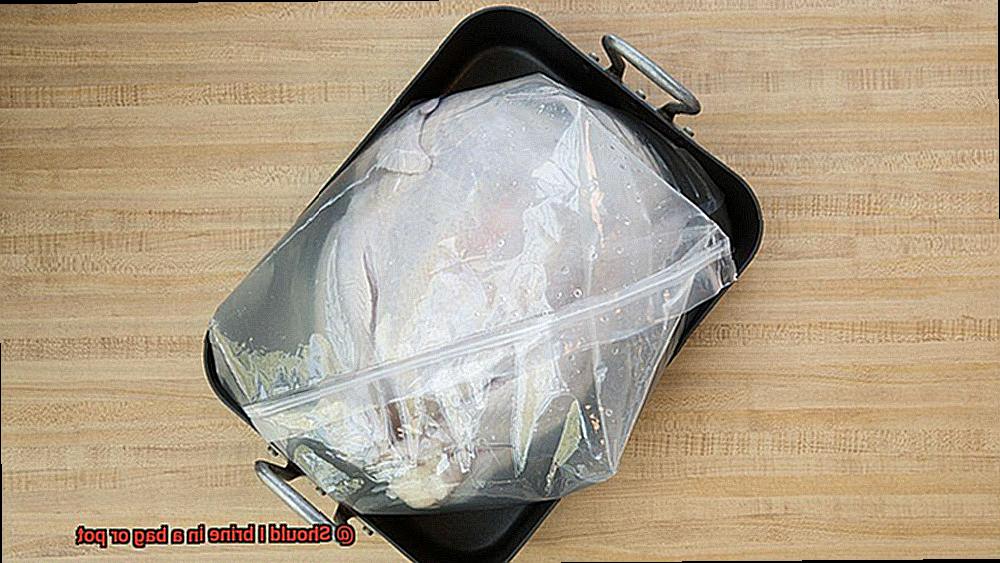
Thirdly, temperature control is crucial. Monitoring the temperature of your meat and brine solution is vital for food safety when brining in a bag. Bags may not provide as much insulation as pots, which can make temperature control more difficult. Pots are usually made of more durable materials that retain heat better than bags.
Lastly, consider how the vessel affects flavor and texture. Using a pot may result in firmer texture due to constant circulation of the brine solution. Some believe that using a pot allows for more even distribution of flavors throughout the meat.
Tips for Successful Brining
Brining is a fantastic way to elevate the flavor and moisture of your meat before grilling, but the container you choose can make a significant difference in the success of your brine. In this article, we’ll explore the pros and cons of using a bag versus a pot for brining.
Bag Brining:
One advantage of using a bag for brining is its convenience. It doesn’t take up as much space in the refrigerator and can be easily disposed of after use, eliminating the need for clean-up. Bags also provide more precise measurement of ingredients, resulting in a more consistent brine.
However, bags may not be as durable as pots, which can lead to leaks and spills. They may also be unsuitable for larger cuts of meat or those with irregular shapes.
Pot Brining:
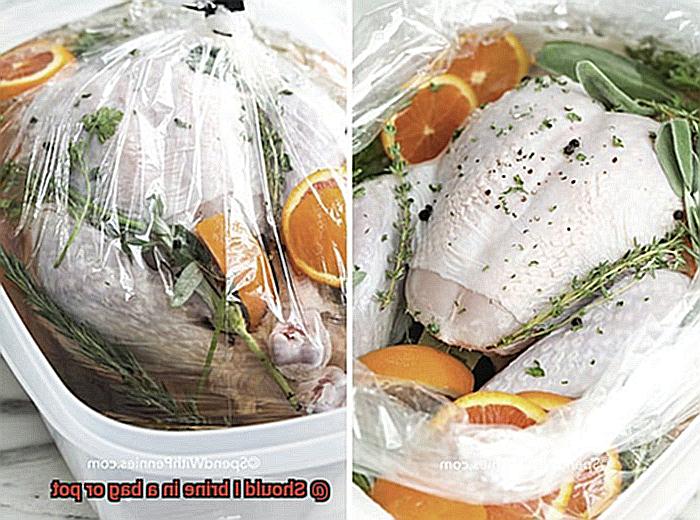
Using a pot for brining allows you to brine larger quantities of food at once, making it ideal for family meals or gatherings. Pots are also reusable and can be used for other cooking purposes. The shape of a pot allows for better coverage of the food being brined, ensuring that all parts are evenly coated.
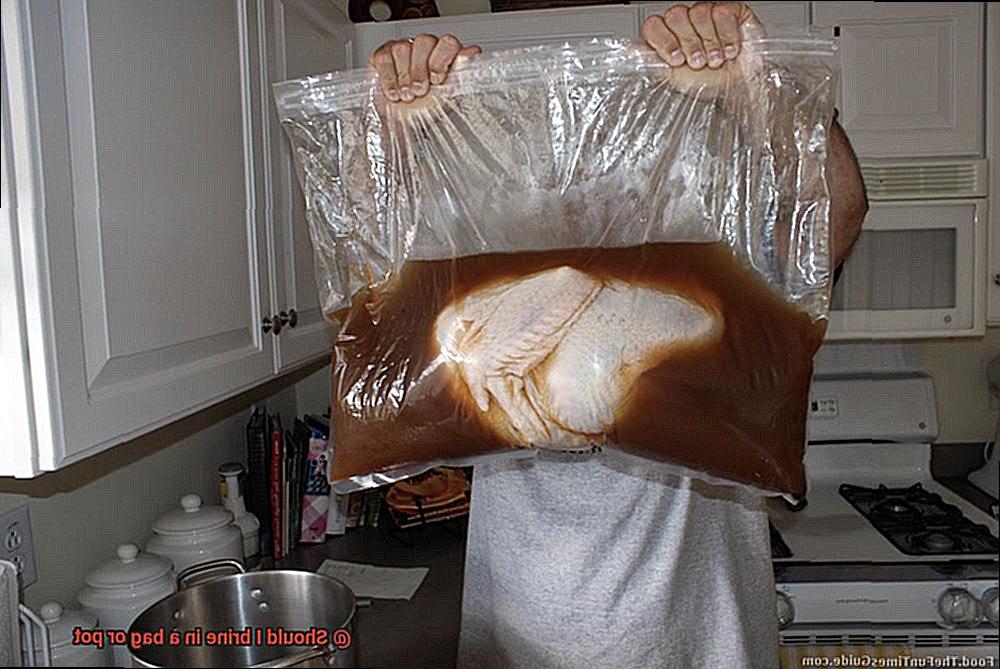
On the downside, pots take up more space in the refrigerator and may require more clean-up after use. They may also be less precise in terms of ingredient measurement.
Tips for Successful Brining:
No matter which container you choose, several tips will ensure successful results. Use the correct salt-to-water ratio, fully submerge your meat in the brine mixture, and choose a container that is large enough to accommodate it.
If you’re using a bag, remove as much air as possible before sealing it to ensure even distribution of the brine. If using a pot, make sure to stir the mixture often to ensure all parts of the meat are coated.
Finally, rinse your meat thoroughly after removing it from the brine to remove any excess salt. Pat it dry with paper towels before cooking to ensure a crispy exterior.
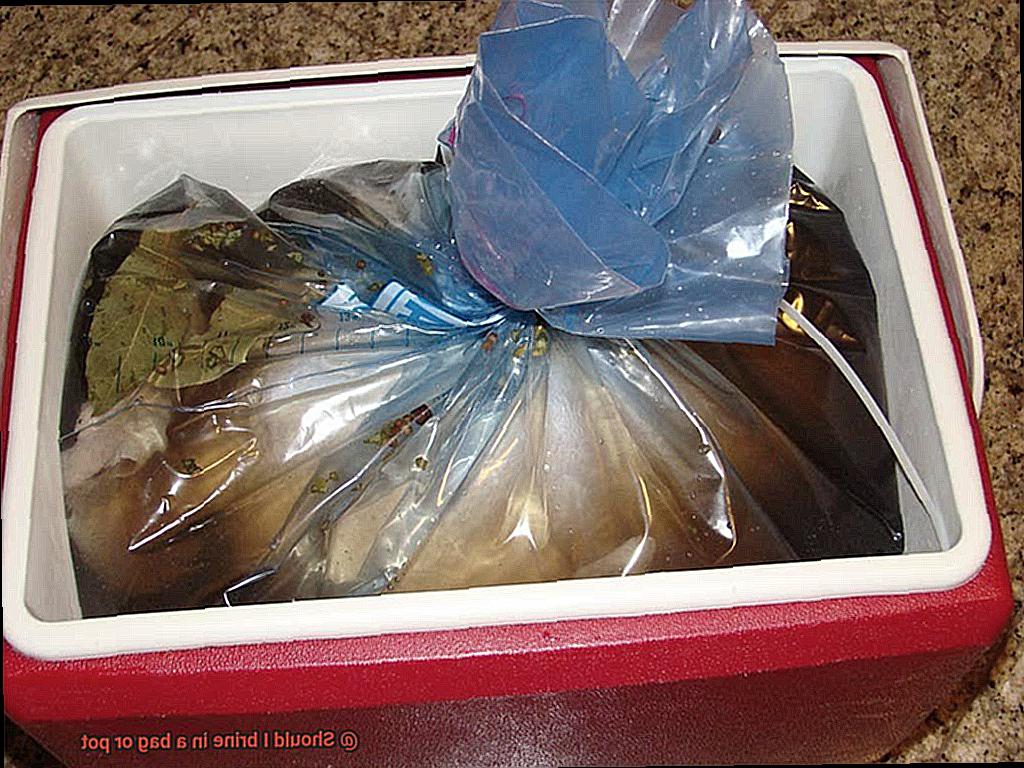
Common Mistakes to Avoid When Brining
Brining is a culinary technique that can elevate the flavor and moisture of your meat. However, it’s essential to avoid common mistakes that can lead to an unpleasant outcome. To ensure that your brined meat is always perfect, here are some tips to avoid the most common mistakes when brining.
First and foremost, precision is crucial in measuring your salt and water. Inaccurate measurements can result in either an overly salty or diluted brine, which can affect the overall taste and texture of your meat. Therefore, measuring your ingredients carefully is essential.
Another mistake to avoid is over-brining your meat. Over-brining can lead to a mushy texture and an overwhelming salty flavor. Follow the recommended brining time based on the size and type of meat you’re using. Resist the temptation to leave your meat in the brine for longer than necessary.
Choosing the right container for brining is also vital. Whether you choose to use a bag or a pot, make sure it’s the correct size for your meat. If you choose a container that’s too small, your meat may not be fully submerged in the brine, resulting in uneven flavoring.
Finally, rinsing your meat thoroughly after brining is crucial. This step removes any excess salt or seasoning from the meat. If you don’t rinse properly, your meat may end up too salty or have a strange aftertaste.
Different Types of Food Suitable for Brining
Brining is a cooking technique that has been used for centuries to enhance the flavor and moisture of food. Not all types of food are suitable for this method, but there are many that can benefit greatly from it. Here are five different types of food that are perfect for brining:
Meat
Brining is an excellent way to make meat juicier and more flavorful. Chicken, turkey, pork, and beef can all be brined to great effect. The saltwater solution helps the meat retain moisture, which prevents it from drying out during cooking. Additionally, brining breaks down the muscle fibers, resulting in a more tender texture.
Seafood
Fish such as salmon and trout can be brined to add moisture and flavor. Brining helps to remove any fishy odors or flavors, especially in stronger-tasting fish. Shellfish like shrimp and scallops can also benefit from brining, as it enhances their natural sweetness.
Vegetables
While less common, some vegetables like cucumbers and carrots can be brined to add flavor and preserve them. Brining vegetables helps them retain their crispness while infusing them with a salty flavor. It’s also an excellent way to make pickled vegetables.
Poultry
Chicken and turkey are two of the most popular meats for brining. They tend to dry out easily when cooked, but brining helps keep them moist and tender. This results in a more flavorful and juicy end product.
Pork
Pork chops, roasts, and ribs are other meats that can benefit from brining. Like poultry, pork can dry out during cooking, but brining helps prevent this from happening. The result is a more tender and flavorful meat.
When deciding whether or not to brine a certain food item, it’s important to consider its natural flavor and texture, as well as the cooking method you plan to use. Brining is best suited for foods that will be grilled, roasted, or smoked, as these methods can dry out the food quickly if not properly prepared.
How to Clean and Store Equipment After Use
Grilling is a beloved pastime, but taking care of your equipment is crucial to maintain its quality and longevity. Here are 5 sub-sections explaining how to clean and store your grilling equipment after use.
Remove Excess Food and Debris:
After grilling, remove any excess food or debris with a grill brush or scraper. This is the first step in cleaning your equipment as it prevents any buildup that can lead to rust or corrosion. Scrub thoroughly and ensure that all food particles have been removed.
Wash With Warm Soapy Water:
Use warm soapy water and a sponge or cloth to wash your equipment. Avoid using abrasive cleaners or steel wool as they can scratch the surface of your equipment. Rinse with clean water and dry it completely with a towel. This will prevent moisture from accumulating and causing mold or mildew growth.
Use A Degreaser:
For stubborn stains or grease buildup, use a degreaser or grill cleaner. Be sure to follow the instructions carefully and avoid getting any cleaner on the handles or other non-metal parts of your equipment. This will help keep your equipment looking new and free from dirt and grime.
Store In A Dry Place:
After cleaning, it’s important to store your equipment properly to prevent any damage or rusting. Store your tools in a dry place that is protected from the elements. You can also use a grill cover to protect your grill from dust, dirt, and moisture. This will keep your equipment safe from environmental factors that can cause rust or corrosion.
Season Cast Iron Grates:
If you have cast iron grates, it’s important to season them before storing. Coating the grates with oil and heating them on the grill for about 20 minutes will help prevent rust and keep them in good condition. This will also improve the flavor of your food by adding seasoning to the grates.
povvINECyb0″ >
Conclusion
In summary, brining is a game-changer when it comes to elevating the taste and texture of your meat and poultry dishes. Whether you opt for a bag or pot, both methods have their pros and cons. Using a bag makes for easy clean-up, even coverage, and convenience, while using a pot allows for better temperature control and more precise ingredient measurement.
When deciding between the two vessels, consider factors such as the size of your meat, ease of use, temperature control, and how each method affects flavor and texture. Remember to measure your ingredients carefully, fully submerge your meat in the brine mixture, and rinse thoroughly after removing from the brine.
Lastly, maintaining your grilling equipment is crucial for preserving its quality and durability. Clean with warm soapy water or degreaser after every use and store in a dry place away from environmental elements that can cause rust or corrosion.

